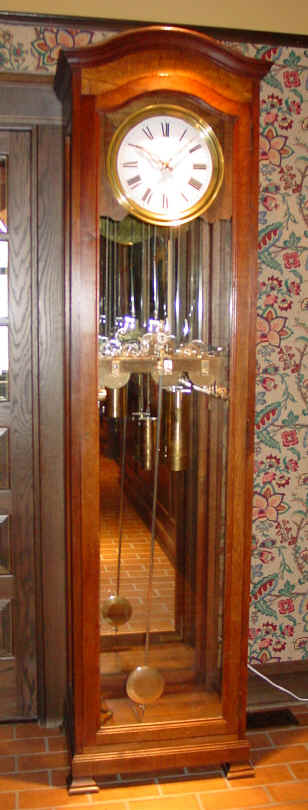| Jean Wagner,
Paris, France c. 1860. Movement net - 15.5" w x 9"h x 7"d, tall case -
22"w x 91"h x 16"d. Three train, four day (single drop, may have been an
eight day with a compound weight drop) in original mahogany wood tall case. Count-wheel
quarter striking 'bim-bam' on two bells, with half-hour and hour on lower, third bell.
Unusual type of gravity escapement based on Thomas Reid's design of about 1818. It uses a
Graham dead beat type escape wheel acting upon specially designed inclined pallets to
raise gravity arms used to impulse the pendulum. Harrison maintaining power. Seconds
pendulum. All parts highly polished. Click on the picture to go to a page for more detail. A unique 1:3 scale miniature of a full-sized three train by the Wagner firm. With the exception of the escapement (which is more complicated than in a conventional clock) this movement is identical in all respects and complexity to what a full sized movement would encompass. It is likely this was produced as an exhibition piece for the Paris fair of 1861. In 1870 the firm of Collin took over Wagner. Their catalog of 1887 depicts a drawing showing another miniature, stating that it was residing in a palace in Spain. Outside of this catalog reference I know of no other examples of Wagner miniatures. Another example of a miniature tower clock by Gourdin. Flat bed style domestic clocks that roughly resembled the design of a tower clock were quite popular in France in the later 1800's and are known as Portico clocks. However, true miniatures that replicate an actual tower clock in every detail and function, especially when made by an actual tower clock company, are very rare. |
